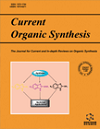-
oa Editorial [Hot Topic: Functional π -Electron Systems: Organic Synthesis for Efficient Plastic Electronics (Guest Editor: Assunta Marrocchi)]
- Source: Current Organic Synthesis, Volume 9, Issue 2, Apr 2012, p. 149 - 149
-
- 01 Apr 2012
- Previous Article
- Table of Contents
- Next Article
Abstract
π-Conjugated organic small molecules and polymers have found a number of applications for use in plastic electronics. One key aspect of organic materials is their versatility. Organics exhibit a remarkable flexibility in the synthesis at molecular level, allowing for tunability of a wide range of properties. Additionally, their use offers the prospect of low manufacturing costs, large area coverage, lightweight and compatibility with flexible substrates. This special issue of Current Organic Synthesis is dedicated to this exciting research area, focusing on the latest developments in the design and synthesis of functional π-electron systems, their bulk and surface/interface self-assembly, their structureproperty- performance relationships, and device applications. To highlight the breadth in scope of this area, contributions from world-class leading scientists whose research addresses organic materials but from quite different perspectives and in varying context are gathered together. The Authors provide an up-to-date discussion on main and emerging applications, spanning photovoltaics (OPVs, DSSSCs), light emitting devices (OLEDs), electrochemically-gated transistors, sensors, and nanoelectronic devices. Fluorinated poly(p-phenylenevinylene)s and their oligomeric counterparts represent an attractive class of materials for electroluminescent device applications, which is extensively reviewed in the article by G. Farinola et al. The review focuses on the synthetic methodologies, and also discusses structure-(electro)optical properties relationships as a function of the number and positions of the fluorine atoms on the conjugated backbone. S. Achelle et al. summarize recent advances in molecular design and synthesis of pyrimidine π-conjugated architectures, and their applications as organic field-effect transistors, liquid crystals, sensors, and non-linear optical (NLO) materials. Mechanically interlocked molecules such as catenanes and rotaxanes are finding interesting applications in the field of artificial molecular machines and electronic devices, due to the availability of new and efficient template-directed synthetic protocols. Both kind of materials have been reviewed in detail in the articles by D. Lanari, L. Vaccaro et al. and by G. Fioravanti, respectively. A comprehensive overview on the computational investigation of representative examples of metal-free organic dyes employed as photosensitizers in dye-sensitized solar cells (DSSC), is given in the article by M. Pastore, F. De Angelis et al. This review also focuses on the matching between theoretical calculations and experimental measurements.


